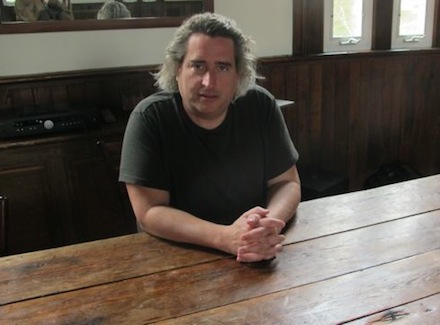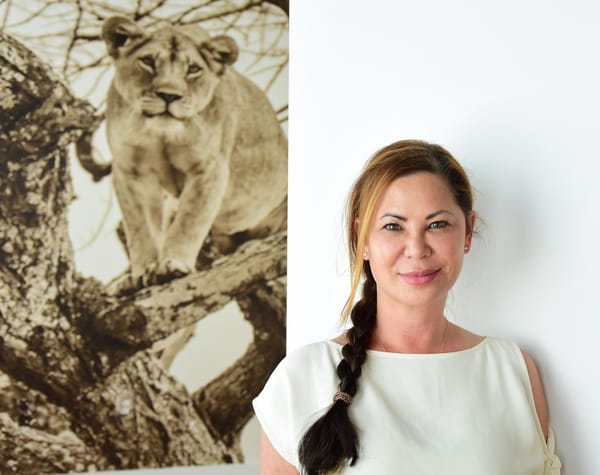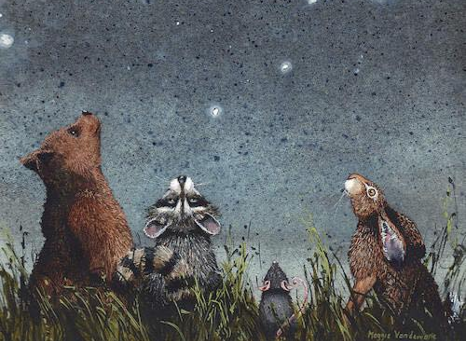When Gregory Crewdson was 16, he had his first fifteen minutes of fame in the form of a three-minute pop song. Crewdson played guitar in a new wave band called The Speedies, and in 1979 they had a minor hit with the song "Let Me Take Your Photo," which Crewdson co-wrote with the band's pretty-boy frontman, Eric Hoffert. At that time, Crewdson could never have imagined how weirdly prescient the song was, nor that he would grow up to be a rock star – not in the music scene, but in the art world. Today, Crewdson is indisputably one of the brightest stars in the universe of art photography. His reputation soared on the strength of a body of work called Beneath the Roses, which was produced in the Berkshires from 2002 – 2008. During most of that time, cameraman Ben Shapiro was on hand to record Crewdson's progress and process, first hired by producers of two short documentaries, and later shooting on his own, gathering footage for what was to become his debut film, Gregory Crewdson: Brief Encounters, which is the closing selection of the Berkshire International Film Festival (May 31 – June 1).
_.jpg)
Gregory Crewdson: Brief Encounters is one of many films in the BIFF with strong local connections; both Crewdson and Shapiro spent a good deal of their youths in the Berkshires, and both still remain rooted here. Shapiro’s father was a psychologist at Austen Riggs; both his sister and his parents have homes in Monterey, where Shapiro is a frequent weekend guest. Crewdson’s father was one of the founders of a 500-acre land trust, Becket Hills, where his family built a log cabin getaway. The land trust was sold a few years ago, but Crewdson now has his own Berkshire haven – a deconsecrated church outside of Great Barrington.

Sitting at a long wooden table in his sparsely furnished church, the man known for creating the most cinematic, enigmatic photos was direct and open about his work, his life, how it felt to be on the other side of the lens as the subject of a documentary, and his connection to this region. Crewdson says he finds inspiration in the Berkshires for reasons that remain mysterious even to him, but that he’s following in the footsteps of artists he admires. “Certain artists are drawn to a certain place for one reason or another that connects to your imagination – I think of John Cheever, or Edward Hopper, or William Faulkner,” he says. “The first pictures I made here were when I was in college. I went to SUNY Purchase undergraduate, and I started making pictures of a nondescript red car in front of a suburban house. I think I’ve been making some version of that picture over and over ever since.” “I started really seriously photographing in the area when I was at Yale as a graduate student between 1986 and ’88. That was when I really started working with storytelling and psychological undercurrent, and using light and color to tell a story. I was less interested in using this place in a documentary way; I was always interested in using it as a backdrop to explore my own fears and anxieties. I’ve always been trying to create a photographic language that hovers between reality and fiction. That’s really important.”
_.jpg)
Even the most unschooled observer can sense the narrative tension in a Crewdson photograph; if you haven’t seen one in person, it’s well worth a visit to the Berkshire Museum in Pittsfield, where ‘Untitled (from the series Beneath the Roses)’ (2004) currently hangs in the Feigenbaum Hall of Innovation. This massive, color-saturated print depicts a car stopped in the middle of an intersection at twilight. There’s woman in the passenger seat, but the driver’s seat is empty, and the door is open. Steam rises up from North Street, where the image was shot, just down the road from the Museum. There’s definitely something out of the ordinary going on, but what that is remains a mystery. It could be a scene from David Lynch’s Blue Velvet, a film that Crewdson cites as inspirational. Crewdson has fond memories of going to Pittsfield to see movies as a kid, when cinemas dotted North Street. He often takes his own children – Lily, who is 4, and Walker, 7 – to Berkshire Museum, but he says they are unfazed by the fact that their dad’s work hangs on the wall. “It’s very moving to have it there, but my kids haven’t really seemed to notice. They’re much more interested in the aquarium downstairs and the poop exhibition. They love that; that’s mesmerizing to them.”
_.jpg)
Whereas Crewdson remains mesmerized by Pittsfield, the setting for most of his Beneath the Roses location shots, in which he used rain, fog, and snow machines; rented cranes for elaborate lighting; and enlisted the aid of the police department to shut down streets, or the fire department so that he could shoot burning buildings, as well as hiring special effects experts and other filmmaking professionals. His shoots nearly always took place at twilight, to capture a perfect moment against a moody sky. His interior shots for the series were produced at MASS MoCA, where he turned the Hunter Center into a soundstage for weeks at a time, and hired an entire crew to build intricate sets and create scenes that are both mundane and unnerving. Says Joe Thompson, MASS MoCA’s director, “For Ophelia – the shot of the woman floating in the flooded living room – we helped Gregory build a living room, and then flooded it with water. Gregory is a thoughtful artist/director: I remember that he warmed the water so the model wouldn't freeze.” Crewdson is now a member of the MASS MoCA board of directors.

Nearly all the cultural institutions of the Berkshires have had their Crewdson moments. In 2006 the Williams College Museum of Art mounted a show contextualizing his work with Edward Hopper, one of his clearest influences. He has given talks at the Norman Rockwell Museum, and he’s pleased that Gregory Crewdson: Brief Encounters, will receive one if its first public screenings at the Mahaiwe. Says Crewdson, “We were very close family friends with Pauline Kael (the New Yorker film critic who had a house in Great Barrington), and she used to invite us to screenings after hours at the Mahaiwe when I was a child…. It’s great to have this connection to not only making pictures here but also being in the dialog, and doing what I can do to help, to do everything that I can do to be supportive of these institutions.” The most cinematic of photographers admits that having the camera lens trained on him took some getting used to, but because Shapiro was on his production sets for so long he practically became a member of the crew. “It’s not as if I didn’t notice him,” says Crewdson. “He sort of became part of the fabric of the thing. I never thought an actual movie would come out. The weird thing was, as it happened, all this stuff in my life started happening, my marriage fell apart… The film doesn’t deal directly with this stuff, it’s just weird how the timing of it coincided with all these changes in my life.”
_.jpg)
As Shapiro came close to finishing the documentary, Crewdson recounts, “I saw a working version of it in his apartment. The first time I saw it it was really hard to see – it was hard to see myself in a very unhappy period of my life… I was really stunned. I was kind of speechless at the end of it… Every time I saw it I allowed it to sink in a little bit more… And then I finally saw the final film projected on a large screen at the Beacon Cinema, a private screening, and that was really mind-blowing to see it on a big screen on North Street in the middle of the day essentially in an empty theater, and I was very moved by it.” BIFF founder Kelley Vickery, who was at that screening, has scored a coup. Not only will the June 1 screening at the Mahaiwe be one of the first times this film is shown in public (it premiered in March at SXSW); both Crewdson and Shapiro will be present at the screening (as will many members of the crew), and Crewdson says it will be the only event at which he has agreed to speak.
_.jpg)
Now that he’s been the subject of a film, would this most cinematic of photographers consider making his own movie? “There’s always discussion of making movies. I never rule it out completely.” Hollywood has come calling, he says, and, “I never say no to the conversation, but I never say yes, either. The main reason I haven’t done it is I haven’t found the story that I want to tell as a movie. When I find that, then I’ll consider it. I really like being in the in-between place of photographs and movies. I think enough people make movies, and they do it great. I don’t have to add to that.”

Having embraced the Berkshires historically and creatively, Crewdson is taking a professional stake in the region. He’s shutting down his New York studio and setting up shop in the second building on his property, a former firehouse. And now that the spring semester is over, he has time off from his job as director of Yale’s photography department and is getting back to work. “My next body of work is definitely going to be here, particularly with my studio up and going. I really hope to make inroads on it this summer,” he says. As for what his next series will be, he says, “It’s all the same story, basically. You can’t get away from yourself.” Back in the church, there’s not a trace of photography gear in sight. “I don’t really make pictures in my everyday life. I actually have to remind myself to take pictures of my children. I don’t feel comfortable with the camera in my hand.” Nor is there much of anything else, just some book shelves, a smattering of furniture, a guitar and a teeny tiny drum set, which, Crewdson unnecessarily points out, belongs to his son, Walker. “We’re in a band,” he says, smiling. Rock on. —Bess J.M. Hochstein All images from Beneath the Roses are used with permission of the artist. © Gregory Crewdson. Courtesy Gagosian Gallery.








